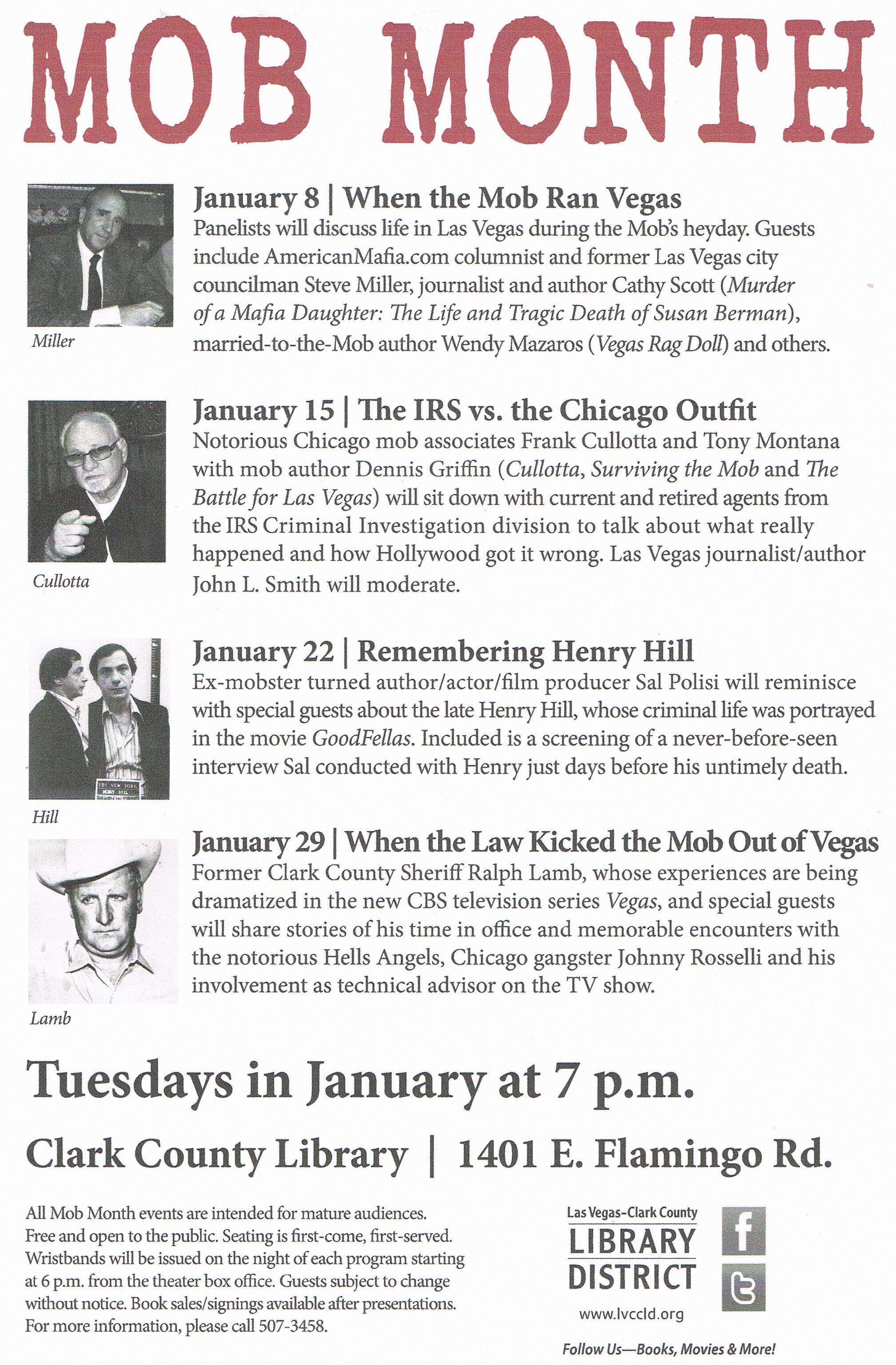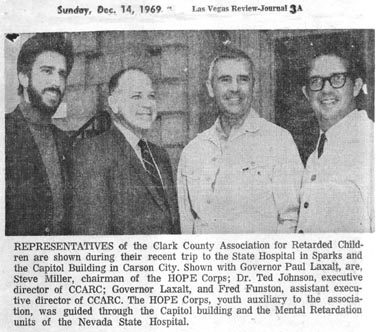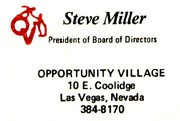When the Kinder
and Gentler Mob Ran Vegas
It was a time when we really
did leave our doors unlocked
INSIDE VEGAS by Steve Miller
AmericanMafia.com
January 7, 2013

LAS VEGAS - For the second year in a row,
the Las Vegas - Clark County Library District will sponsor an event to
help expose the infamous past of our city, its Mob
roots.
We're gonna talk about the Good Ol' Days,
a time in Vegas' history when the skim was the main crime, and small time
hoods who preyed on tourists or locals often ended up in shallow graves
just over the state line.
Drug sales, GHB, trick rolls, human
sex slave trafficking, pay day loan stores, escort
agencies, massage parlors, streetwalkers and pimps, and rip
off strip clubs were not tolerated when the original Mob ran
Vegas. Those guys made sure your visit was completely safe and enjoyable
with a lot of attention paid to our town's quasi-wholesome family reputation.
Of course tourists could still get almost anything they desired, but only
under the watchful eyes of casino bosses and trusted security chiefs.
And for locals, it was a time when we really
did leave our doors unlocked. An era that lasted through the 1970's.
These were the years when Clark County
had less than 200,000 residents, no FBI or IRS offices, and the law was
handed out by cops working under then-Sheriff Ralph Lamb and City Police
Chief John
Moran who practiced something we called "Cowboy Justice."
(Editor's note: The
original Mob guys are spinning in their graves! Today, street thugs, home
invaders, gangs, rip off artists, pimps, GHB peddlers, massage parlors,
escort bureaus, pickpockets, etc. have replaced the old Vegas Mob. Many
are from Asia, Mexico, and Eastern Europe.)
During the years called the "Lamb Dynasty"
beginning in 1961, members of Ralph's family held high public offices statewide,
and for the next 18 years, Las Vegas was the safest city in the nation.
The people who ran the casinos lived here.
They raised their families here. They built schools, charities, churches,
and synagogues. To many, this was their "last resort," and they treated
the town and its citizens with great respect. Most of the original Mob
supported the Lambs.
Though I was only a teenager when Sheriff
Lamb first took office, his brand of justice didn't pass me by. I was a
pain in the ass. A legend in my own mind. I was a kid driving around
town in a new Corvette, had my own nightclub,
radio and TV show,
speedboat, a pocket full of silver dollars, several gorgeous girlfriends,
and led a charmed life. I thought I could do anything, but got
into trouble several times before I turned 18. After I was forced to
grow up by Sheriff Lamb and his friend Big Mike O'Callahan, the Sheriff
and I became friends, and many years later, he and his successor John Moran
encouraged me to run for the City Council.
I grew up alongside the kids of the original
Vegas Mob. They were my friends, schoolmates, customers, and regulars at
the dances and TV show produced by my partner Keith
Austin and I. Their parents would regularly rent the Teenbeat
Club and hire top recording artists along with our bands for their
kid's extravagant Birthday Parties, Bar and Bas Mitzvahs, Sweet 16 Celebrations,
or just because they wanted to show off. At those private and often secretive
celebrations, I met some of our town's most legendary Mob figures as they
celebrated their teenage daughters and sons.
In my review of Cathy Scott's book Murder
of a Mafia Daughter, I had this to say about the book's subject
Susan Berman, one of my classmates at Las Vegas High: "Ms. Scott's book
brings back vivid memories of the spoiled kids of our town's originating
citizens. Susan Berman, may she rest in peace, was one of those kids who
was raised in the lap of luxury only experienced by the sons and daughters
of the Vegas Mafia. Often times the hoods would use their kids as status
symbols, providing the best schools, clothes, cars, etc. to impress their
hoodlum friends. Susan is described in Murder of a Mafia Daughter as a
perfect example of the heretofore ruling class of Vegas, a group who was
cash rich and lacked the class to go with their cash. The book captivates
all readers whether they grew up in Sin City, or not. What an inside look
into the dark side of our town, and Susan Berman, an unfortunate victim
of an unsolved murder. A victim because she wanted to maintain the life
style she grew up enjoying, but could no longer afford after the untimely
death of her Mob father."
 Using
my local media contacts, I formed a youth organization called the Hope
Corps that produced social events for people with intellectual disabilities.
Soon, I was appointed to the first board of directors of what then was
known as the CCARC, or Clark County Association for Retarded Children (now
Opportunity Village.) Based on my volunteer work there, I met more
of the people who ran the town. Not the politicians, but those who pulled
the strings like Dave Berman, Susan's father.
Using
my local media contacts, I formed a youth organization called the Hope
Corps that produced social events for people with intellectual disabilities.
Soon, I was appointed to the first board of directors of what then was
known as the CCARC, or Clark County Association for Retarded Children (now
Opportunity Village.) Based on my volunteer work there, I met more
of the people who ran the town. Not the politicians, but those who pulled
the strings like Dave Berman, Susan's father.
I soon learned that "hotel owners" could
be very generous with their casino's cash and facilities, especially if
they got good publicity in return.
In the amazingly accurate movie Casino,
the hotel most often mentioned was called the Tangiers. In real
life, it was the old Stardust,
one of the most prolific supporters of CCARC.
The people who ran the Stardust were front
man Alan
Glick (Philip Green) played in the movie by Kevin Pollak, Frank
"Lefty" Rosenthal (Sam "Ace" Rothstein) played by Robert DiNiro, and
hotel/casino manager Al
Sachs (Billy Sherbert) played by Don Rickles.
In supporting roles, Clark
County Commissioner Darwin Lamb (Pat Webb) was played by L.
Q. Jones, the "belligerent cowboy" was played by long time INSIDE VEGAS
reader Craig Vincent,
and Dick Smothers brilliantly played the part of then-Nevada Gaming Commission
Chairman Harry
Reid.
Up until the early 1970's, Tony
"The Ant" Spilotro (Nicky Santoro) played by Joe Pesci in the movie,
put on a good front by quietly running the gift shop at Circus Circus,
but behind the scenes was becoming more and more involved with the operations
of the Stardust and Fremont
Hotel casinos while secretly breaking every Las Vegas rule about street
crime. Spilotro and his crew began drawing the attention of Sheriff Lamb.
When Frank Rosenthal defied his East Coast
bosses and started his own TV show, Mike Christ, currently known as "AmericanMafia.com
photographer Mike Christ," was the show's producer. Based on his antics,
Rosenthal also drew Lamb's attention as depicted in Casino when
the Sheriff's brother the County Commissioner paid him a visit to ask that
his incompetent nephew be re-hired as slot manager.
While in my early twenties, I was the
sales
manager for my dad's Las Vegas souvenir manufacturing business. My
work brought me into contact with Tony Spilotro and his wife when I visited
their gift shop to replenish inventory. Tony didn't like me. I think I
was too tall, and he had a complex about his height, though I got along
well with Mrs. Spilotro.
However, the managers at the Stardust,
another of my dad's clients, did like me and I soon made friends with Al
Sachs and his partner Herb
Tobman. I told them about the fledgling CCARC, and they offered their
hotel's showroom and convention hall for fundraisers. Thanks to Sachs and
Tobman, many of the stars playing on the Strip performed for free at our
events held at the Stardust. The Stardust connection helped put CCARC on
the map and begin its rise to Las Vegas' favorite charity.
In 1972, I was appointed Vice President
of the charity and coined the more marketable name Opportunity
Village (OV) which still serves the organization well.
 Other
Strip hotels followed the lead of the Stardust, and soon OV was the darling
of the casino owners and their secret bosses. I began making inroads at
the Desert Inn, Dunes, Golden Nugget, Caesars Palace, Frontier, Flamingo,
and Hilton. Then I was elected President of OV.
Other
Strip hotels followed the lead of the Stardust, and soon OV was the darling
of the casino owners and their secret bosses. I began making inroads at
the Desert Inn, Dunes, Golden Nugget, Caesars Palace, Frontier, Flamingo,
and Hilton. Then I was elected President of OV.
During this time, I learned that many of
the casino bosses wanted to clear their names, at least in Nevada. To do
so, they would make huge monetary contributions to OV which were rewarded
with highly publicized honors and awards bestowed on them at lavish banquets
held in Strip and Downtown resorts. I was asked to host many of those events
and give out the awards.
One generous casino boss was Moe
Dalitz, long suspected of being Meyer
Lansky's front man at the Desert Inn and El Rancho. In the early
1970's, Dalitz made a large contribution to OV. A banquet was held in his
honor. The movie Casino came close to replicating this event when
the character "Ace" Rothstein received his "Man of the Year" award at Hartland
Mansion on South 6th Street while receiving accolades from actors playing
Sin
City-type-luminaries.
In real life, it was my responsibility
to present the OV "Man of the Year" award to Moe Dalitz in the Desert Inn
showroom (Only in Vegas!). As I gave Dalitz the plaque, I couldn't help
but notice that the majority of persons cheering for him looked like they
were from a Central Casting call for gangster types and their molls.
In subsequent years, I presented the "Man
of the Year Award" to Steve
Wynn and Al
Bramlet. Then I was given the award. I've kept it hidden
in my attic ever since. My Dad always told me, "You're judged by
the company you keep."
About that time in Vegas history, criminal
defense attorney Oscar
Goodman began his rise to local prominence (Goodman was elected Mayor
of Las Vegas in 1999). Goodman made his initial fortune defending street
level criminals including Tony Spilotro and Frank Cullotta (the Hole in
the Wall Gang) who were miraculously let off every time they appeared with
Oscar in the court of Goodman's former law partner-turned-judge Harry
Clairborne. Cullotta once said that the gang planned their heists in
Goodman's law office conference room.
A new street crime era had begun in Las
Vegas.
In 1979, Sheriff Lamb retired from office
and the Cowboy Justice era came to an end. That's when we began locking
our doors.
These are just some of the stories expected
to be told during Mob Month at the Clark County Library.
(Video tapes of Mob
Month events will be available soon @
http://lvccld.org/events/event.cfm?nID=43387)

